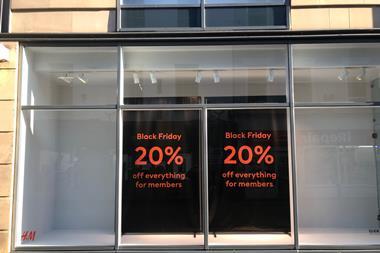Retail Week reports all the agenda-setting retail property stories. Laura Heywood asks experts from the UK’s leading property developers about the reality behind the headlines.

Business rates

The news that one in seven businesses in England were summoned to appear in court last year after falling behind on business rates payments bought the debate about how to help the struggling high street into sharp relief.
The data from the Grimsey high street review highlighted the crippling effect that onerous property taxes are having on businesses as they struggle with the increasing burden. Conducted by former Focus boss Bill Grimsey, the research shows that the use of bailiffs to collect business rates has surged 18.3% since 2010/11.
It is estimated that 262,086 businesses were summoned to appear before a magistrate in 2012. Of those businesses, 131,574 were referred to bailiffs for collection.
Comment
Tim Attridge, head of retail rating, CBRE
These are challenging times for retailers, who are contending with an uneven economic recovery and changing consumer habits. But for many it is business rates that are a pressing concern. In April the cost of business rates to the retail sector rose £175m - a £500m increase over just three years.
Business rates are linked to a historic rental value. The Government’s decision to delay the next rating revaluation until 2017 means retailers will pay business rates based on 2008 rental values.
The British Retail Consortium has described the system as “not fit for purpose” and will lobby the Government for change. Change is overdue but, as business rates represent 5% of all UK tax revenue, a radical shake-up seems unlikely in the short term.
So what can retailers do to mitigate the cost of business rates? Retailers should be alive to the various tax reliefs available to them. Refurbishment works and managing unused space in stores and distribution sites can produce savings.
In addition, opening a new shopping centre in the area, increased vacancy levels, building works or road works may result in a reduced rates bill.
If all physical and economic factors impacting a retailer’s property are considered, there is potential for the burden of business rates to be eased, at least in part. Retailers should remember that it is not simply about how much space you have, but also how you use and manage the space that matters.
High street vacancies by numbers
The high street is expected to recover over a seven-year period, with vacancy rates predicted to drop to 2006 levels by 2020, according to research by property agent Colliers International.
7000 - The number of UK stores that have closed since the downturn began in 2008
7 - The number of years it will take for the high street to recover
2020 - The year empty shop rates will have fallen to match pre-recession levels
7% - The total floor space that will be vacant by 2020
12% - The total floor space that’s vacant at present
4 - Number of years it will take before the UK starts to see a new wave of retail development, concentrated in major regional centres
2025 - The year when supply and demand for retail floor space will reach equilibrium
10m sq ft - The total excess vacant space left by 2025
Source: Colliers International Midsummer Retail Report 2013
Comment
Steve Burnaby, head of retail agency, Colliers International
While the high street recovery will be selective as the major centres have the greatest reduction in vacancy rates and the medium centres experience the least, some of the most active and vibrant retailers taking space at the moment include discounters, overseas retailers, food and beverage retailers, convenience stores and bookmakers.
Although the days of new retailers entering the UK and rolling out acquisition programmes of 300 units is over, the new model is to open 20 to 50 units in the major retail centres and have a strong internet site.
Online sales are about 13% of all non-food expenditure. While they are likely to rise to about 20% by 2020, after this the rate of growth levels off. Therefore, online sales will no longer be as much of a threat to the high street, as successful retailers will have by then aligned their internet and property strategies.
Retailers are focusing on providing an experience in their new larger stores and increasing dwell times by the inclusion of state-of-the-art IT technology, coffee shops and restaurants to provide a retail and leisure experience. There is also a tendency for landlords to increase the levels of food and beverage provision in the schemes.
The combination of limited new supply and continued growth in retail expenditure will lead to reduced vacancy rates and ultimately generate pressure for new town centre development.
Value retailers

It’s the turn of the value and discount retailers to enter the great space race as names such as Poundland, 99p Stores, Aldi and Lidl all go on the expansion trail.
Aldi plans to open 50 c-stores this year while Lidl plans to open 35 to 50 new stores in 2013, adding to its existing UK store portfolio of 600.
In June, Poundland opened 11 shops in 11 days as part of an expansion programme in which the retailer will open more than 50 branches this year, taking its estate to more than 450.
Poundstretcher has also got in on the action, acquiring five stores from Dreams, as well as three from Comet, three from Blockbuster and 12 from Staples.
In June, 99p Stores entered the Scottish market, where Poundworld, Discount UK, Poundland, B&M and Home Bargains already have a growing presence.
Comment
Neil Varnham, managing director, Pradera
Discount retailers have traditionally been stalwarts of the lower-end high streets, but recently they have seen some of the fastest growth in the sector. Poundland is to open more than 50 high street stores this year and others such as B&M, The Range and Home Bargains are marking a real shift in power in the retail park market. A change in consumer shopping trends and an increase in getting value for money across the classes in the past few years have been the reasons behind discount retailers taking a larger share of the public’s purse.
What is interesting about the growth of the discount retailers is that they are not just proving popular with lower income families and are taking units right across the retail property spectrum. In fact their growth is less attributed to high street openings where they traditionally have smaller compact units, but to the expansion to retail parks where they are taking larger retail warehouse units and are able to display the widest range of products.
It is on retail parks where you are seeing them open next to the likes of Next, M&S Simply Food and Laura Ashley as well as the more traditional retail warehouse park operators, such as Wren Kitchens, Halfords and DFS. Consumers have remained thrifty and will now shop comfortably across the range of retailers from discount to full price.
Subletting

Tesco became the latest retailer to sublet sections of its stores to another trader in July in a bid to dispose of excess space.
The grocer revealed it had signed a deal to sublet space in its Stockton-on-Tees store to gym operator Xercise4Less as part of its plans to downsize its larger stores.
Subletting has emerged as a popular way to slim down property portfolios without divesting stores. Tesco’s deal followed B&Q’s decision to split its 120,000 sq ft store in Belvedere, south London and sublet 60,000 sq ft of space to Asda.
Comment
Tim Vallance, head of retail, Jones Lang LaSalle
The rise in landlords and retailers letting to leisure operators is one strategy being employed to innovate real estate and keep up with the changes that multichannel brings to the way people shop. It is also an interesting way to revive struggling stores and to boost custom.
Tesco’s recent deal to sublet space in its Stockton-on-Tees store to gym operator Xercise4Less is a prime example of this trend. Another example is the Curzon Cinema, which opened above the Wimbledon HMV store in 2009.
The initiative allowed HMV a way to add another entertainment string to its bow with an intimate cinema offering a different experience from the large screen multiplex, which has proved successful despite HMV’s administration.
Obtaining a change-of-use consent is necessary for these schemes and that can sometimes take time.
However, this is not stopping landlords and retailers recognising the benefits and the increased custom that can result for either operator on the back of sharing the same premises. For instance, the former TJ Hughes store on Watford high street will be split into retail and leisure stores potentially including operators such as gyms and restaurants.
Leisure providers are good partners as they offer stable and secure rental income as well as a complementary use.
There is also a trend for people who feel they can’t indulge in big purchases because of economic constraints buying quick pick me ups, such as meals or a cinema ticket. This ‘lipstick leisure’ effect means that the leisure sector is also proving fairly recession-proof, boding well for budding retail and leisure subletting partnerships.
International
The UK remains a big draw for international brands. US wedding specialist David’s Bridal and US casualwear retailer J Crew are among the latest names to try their luck in this mature market.
David’s Bridal has revealed its intention to open a store in every major UK city in the next five years. It comes as the retailer prepares to open its first store - a two-floor 10,000 sq ft flagship - in this country in Westfield Stratford City.
J Crew is also hard at work fitting out its new menswear store ahead of its much-anticipated UK debut in November.
The launch of the store at 38 Lamb’s Conduit Street in Bloomsbury, London is part of the retailer’s plans to open five different formats across London.
UK brands are looking outside the domestic market for expansion opportunities. George at Asda is embarking on the latest stage of its overseas offensive with its first store in Southeast Asia, while SuperGroup has inked a deal with retail distributor and operator FJ Benjamin to expand its presence in Asia into Malaysia and Singapore.
Fashion retailer Fat Face is eyeing the US, where it plans to open its first store on the east coast in the next two years.
Fellow fashion retailer Phase Eight is also ramping up its overseas growth with plans to build its presence five-fold this year as it aims for 50 overseas stores and concessions by the end of 2013.
In the lower-end fashion arena New Look is preparing to launch in China and Russia.
Comment
Russell Loveland, senior asset manager, Lend Lease Retail
With demand from international brands outstripping supply in London’s West End, what can the rest of the UK do to benefit from this overseas appetite for growth?
The good news is that there is appetite from such brands for locations outside central London. In excess of 30% of Bluewater’s rental income, for example, is derived from international retailers.
The challenge, however, is attracting global brands in a competitive market, particularly when so many are new entrants to the UK.
So what drives success? In our experience, it is effective asset management - more specifically, a focus on insight, relevance and proactivity.
It is vital to understand not just the ‘what’ (how big and worth how much), but the ‘why’ (behaviours and lifestyles) of the catchment. Such insight helps to drive demand by building confidence.
In terms of relevance, being able to demonstrate the alignment between international brands, the asset, and the catchment, is critical. So is providing the space, adjacencies and other offers, such as dining and entertainment, which will allow such brands to thrive.
Driving demand by being proactive is essential in getting to the top of a brand’s acquisition list. Proactivity is also about managing out brands that do not fit to create opportunities for those brands that do.
The approach has worked with great success at Bluewater, and the principles apply to other locations too.
Knowing your catchment, understanding the brands you are targeting, and showing the match between the two is a journey everyone can make.


























No comments yet